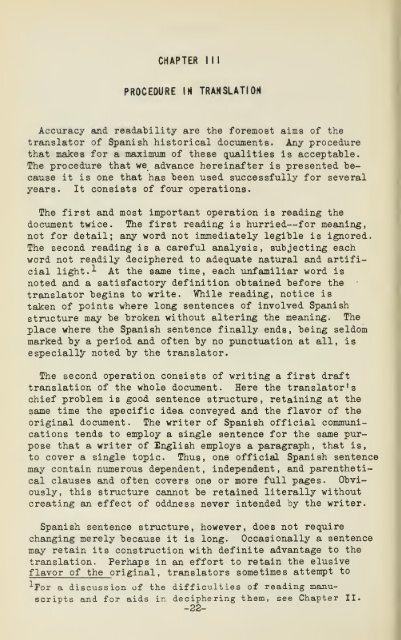Handbook for translators of Spanish historical ... - University Library
Handbook for translators of Spanish historical ... - University Library
Handbook for translators of Spanish historical ... - University Library
Create successful ePaper yourself
Turn your PDF publications into a flip-book with our unique Google optimized e-Paper software.
CHAPTER III<br />
PROCEDURE IN TRAMSLATIOH<br />
Accuracy and readability are the <strong>for</strong>emost aims <strong>of</strong> the<br />
translator <strong>of</strong> <strong>Spanish</strong> <strong>historical</strong> documents. Any procedure<br />
that makes <strong>for</strong> a maximum <strong>of</strong> these qualities is acceptable.<br />
The procedure that we advance hereinafter is presented because<br />
it is one that has been used successfully <strong>for</strong> several<br />
years. It consists <strong>of</strong> four operations.<br />
The first and most important operation is reading the<br />
document twice. The first reading is hurried— <strong>for</strong> meaning,<br />
not <strong>for</strong> detail; any word not immediately legible is ignored.<br />
The second reading is a careful analysis, subjecting each<br />
word not readily deciphered to adequate natural eind artificial<br />
light. -^ At the same time, each unfamiliar word is<br />
noted and a satisfactory definition obtained be<strong>for</strong>e the<br />
translator begins to write. While reading, notice is<br />
taken <strong>of</strong> points where long sentences <strong>of</strong> involved <strong>Spanish</strong><br />
structure may be broken without altering the meaning. The<br />
place where the <strong>Spanish</strong> sentence finally ends, being seldom<br />
marked by a period and <strong>of</strong>ten by no puncttiation at all, is<br />
especially noted by the translator.<br />
The second operation consists <strong>of</strong> writing a first draft<br />
translation <strong>of</strong> the whole document. Here the translator's<br />
chief problem is good sentence structure, retaining at the<br />
same time the specific idea conveyed and the flavor <strong>of</strong> the<br />
original document. The writer <strong>of</strong> <strong>Spanish</strong> <strong>of</strong>ficial communications<br />
tends to employ a single sentence <strong>for</strong> the seune purpose<br />
that a writer <strong>of</strong> English employs a paragraph, that is,<br />
to cover a single topic. Thus, one <strong>of</strong>ficial <strong>Spanish</strong> sentence<br />
may contain numerous dependent , independent , and parenthetical<br />
clauses and <strong>of</strong>ten covers one or more full pages. Obviously,<br />
this structure cannot be retained literally without<br />
creating an effect <strong>of</strong> oddness never intended by the writer.<br />
<strong>Spanish</strong> sentence structure, however, does not require<br />
changing merely because it is long. Occasionally a sentence<br />
may retain its construction with definite advantage to the<br />
translation. Perhaps in an ef<strong>for</strong>t to retain the elusive<br />
flavor <strong>of</strong> the o riginal, <strong>translators</strong> sometimes attempt to<br />
^For a discussion <strong>of</strong> the difficulties <strong>of</strong> reading manuscripts<br />
and <strong>for</strong> aids in deciphering them, see Chapter II.<br />
-22-










![Novellen [microform] - University Library](https://img.yumpu.com/21939450/1/171x260/novellen-microform-university-library.jpg?quality=85)
![Anecdota Chisiana de re metrica [microform]](https://img.yumpu.com/21939448/1/190x239/anecdota-chisiana-de-re-metrica-microform.jpg?quality=85)



![Schollenbruch [microform] : Gedichte - University Library](https://img.yumpu.com/21939437/1/174x260/schollenbruch-microform-gedichte-university-library.jpg?quality=85)

